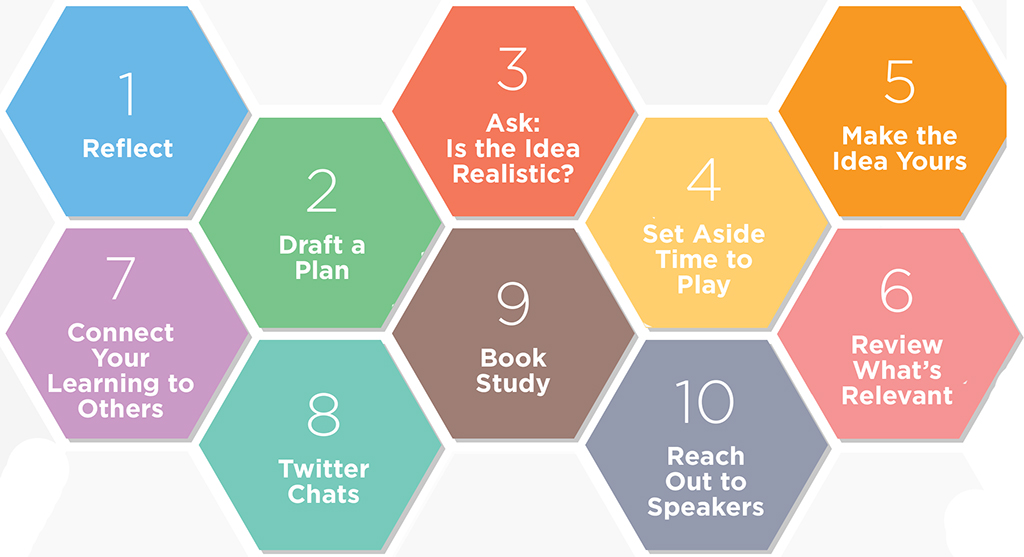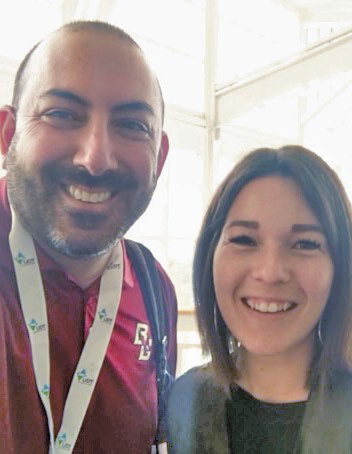10 Tips for Turning Ideas into Action Reflection in Education
Conference presentations, networking, and notebooks filled with innovative next steps—oh, my!

Conference presentations, networking, and notebooks filled with innovative next steps—oh, my! At the Future of Education Technology Conference (FETC) in Orlando in January, we were excited to see some great presentations, awesome keynotes, and student showcases, and we also met some new educators to add to our PLCs. But how do we keep that momentum moving forward?
Here are ten strategies for implementing new ideas and for sharing your learning with others who weren’t able to attend.

1. REFLECT
It’s important to take time to reflect before jumping into new ideas or strategies. Three days full of speakers and breakout learning at FETC gave everyone a lot to soak in. Even with a Google doc filled with every note your fingers could type, there’s no way to remember it all. Collect your notes, set aside time to revisit them, and identify some specific action items.
2. DRAFT A PLAN
Give yourself a week to draft out a plan to implement any new learning. As tempting as it might be to put things into practice right away, mapping out a plan is often the most effective strategy. Most educators collect new strategies and innovative ideas but then relegate time to do this reflective thinking to the bottom of their to-do lists. Conferences like FETC can help you to re-evaluate your work, lessons, and instruction.
3. ASK: IS THE IDEA REALISTIC?
Tools and ideas to transform education. Sign up below.
Unrealistic ideas, goals, and strategies are almost worse than not having any at all. Just because students in some classes blog twice daily to generate more learning doesn’t mean you can implement the same idea when you don’t have the environment or tools to do that.
If it is a realistic goal or idea, set your plan in motion. If it seems too far out of reach, set a goal to further brainstorm ideas three months from now for making this unrealistic goal a realistic dream. Sometimes it’s just not the right time, but that doesn’t mean it’s not an option for the future.
4. SET ASIDE TIME TO PLAY
The implementation of new ideas is only as good as your ability to understand what impact a change would make. Try out two new resources or tools a week that you didn’t know about before the conference. Make a list of all the tools you want to try and set aside a few minutes a week to play with the new technology. Do your research, explore the data, connect with other users, and brainstorm each tool’s possible uses.
5. MAKE THE IDEA YOURS
Tailor any new strategies to fit your style. The implementation will not be believable and sustainable if you repeat a speaker’s message, as valuable as it may have been, without making the idea your own. Take the idea and combine it with your teaching strengths and your students. Only then will it have an impact.
6. REVIEW WHAT’S RELEVANT
Look through your notes and identify which elements of each session are applicable and relevant to your school or classroom. Although there are always tons of great ideas, vendors, tools, and strategies, if they don’t fit your current culture or teaching style they’re not going to be relevant to your learners.
Unsure where to begin in assessing an idea’s relevance? Consider your goals for the year. Does this idea or tool support your mission to reach that goal? If the answer is “yes,” go for it. If the answer is “not quite,” place the idea off to the side for now. It’s important to stay focused on achieving your initial goals first. Once you reach those, you can set new goals.
If you’re nervous you’ll forget about this awesome tool or idea, Set a calendar reminder for six months from now with your notes and web tools linked. It doesn’t need to be goodbye forever—just “see you later.”
7. CONNECT YOUR LEARNING TO OTHERS
As you review your notes, you may discover tools that would benefit other colleagues. Don’t keep them to yourself. Share your notes and links with that educator. Although you may not be in a position to make this knowledge purposeful, someone else may be able to make the idea blossom.
8. TWITTER CHATS
Find chats with common interests and discuss these topics and trends from the conference. Allow the conference topics to be a starting point or stimulus for taking things further, rather than an ending point.
If you’re unsure how to find the right chat, tweet it out. Share your desired topic hunt in a quick tweet and ask your #PLN what twitter chats are right for you. Don’t forget to tag Matthew X. Joseph (@MatthewXJoseph) and Rae Hughart (@RaeHughart) in your tweet so we can share your question too. That’s what a network is for.
9. BOOK STUDY
Many speakers at conferences like FETC have either written books themselves or suggest books for further reading during their presentations. They’re also able to recommend books in their area of expertise if asked to do so. Select one text and talk it up in your school. You may be able to find a small group to start a book study and dive more deeply into the book together. This is a wonderful opportunity to bounce your ideas off trusted colleagues.
10. REACH OUT TO SPEAKERS
The speakers and panelists at any conference are likely key experts in your field and also very open to share. Don’t be afraid to ask these presenters questions via email or social media. Twitter, Instagram, Facebook, and Voxer can be great avenues to connect with your favorite presenters and learn more.
Dr. Matthew X. Joseph (@ MatthewXJoseph) is Director of Digital Learning and Innovation for Milford Public School, Milford, MA. Rae Hughart (@RaeHughart) is a Middle Level Math Educator in Illinois and the Director of Training & Development for Progressive Mastery Learning, LLC.
